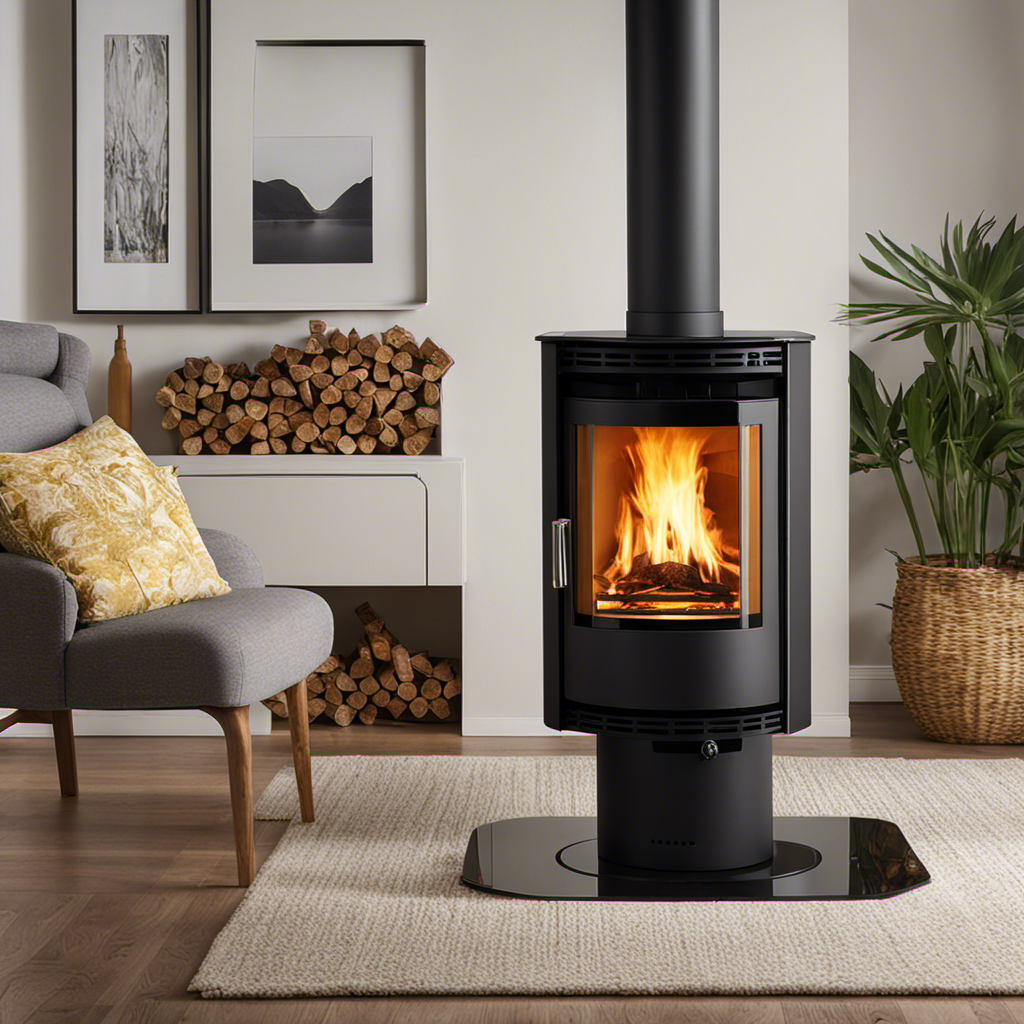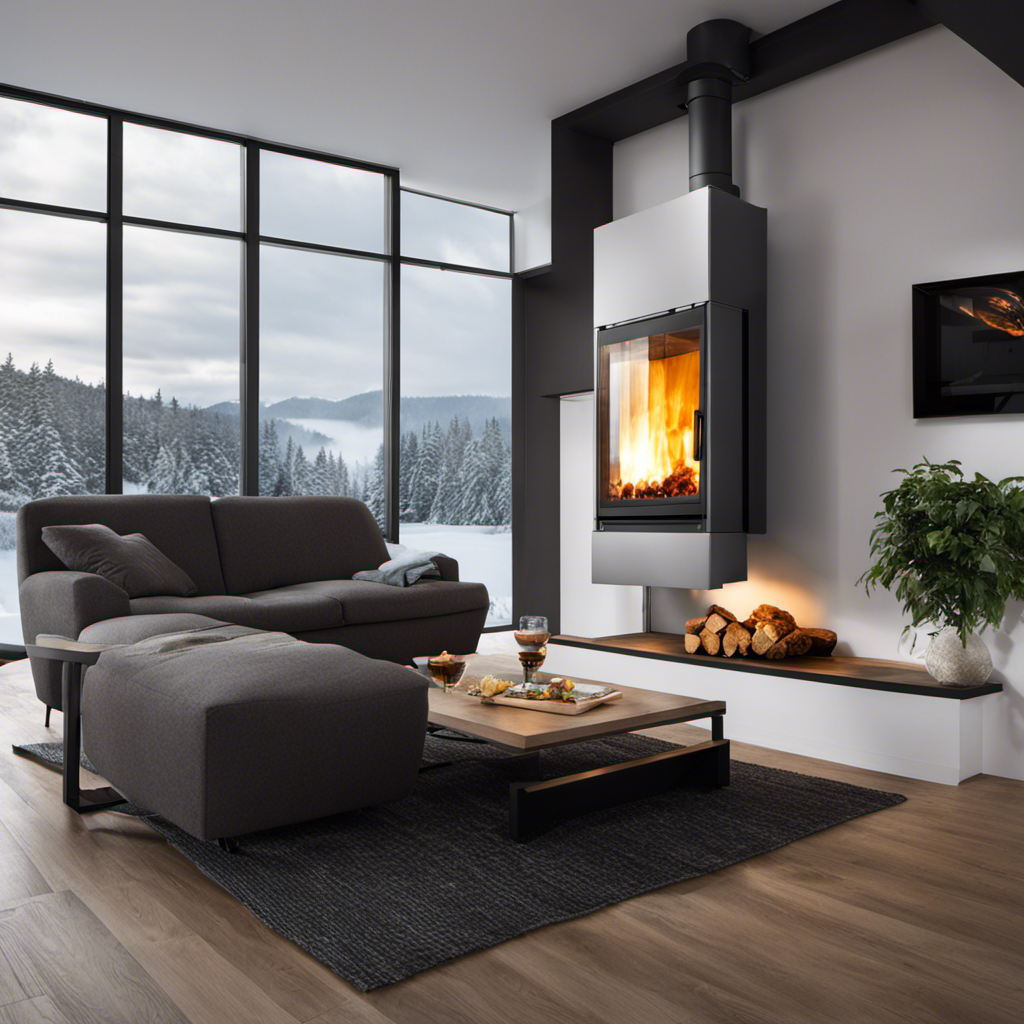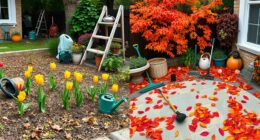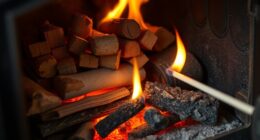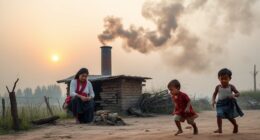As someone who deeply appreciates the art of grilling, I find the advanced technology behind wood pellet grills utterly captivating. The way they flawlessly combine contemporary tech with traditional barbecue techniques always impresses me.
So, how does a wood pellet grill work? Let’s dive into the intricate details of its mechanics and technology, from the efficient auger system that feeds the pellets to the precise temperature control mechanism.
Get ready to uncover practical insights and tips for maximizing your wood pellet grill’s performance.
Key Takeaways
- Wood pellet grills use wood pellets as fuel and achieve combustion through an electric heating element or hot rod.
- The auger system feeds the wood pellets from the hopper into the fire pot for burning, allowing for precise temperature control by adjusting the auger speed.
- The digital control panel regulates and maintains temperature, while the ignition system ensures consistent and reliable starts.
- Regular maintenance of the auger system, heat diffuser, and drip tray is crucial for optimal performance and to prevent issues such as temperature fluctuations and grease buildup.
The Basics of Wood Pellet Grills
Wood pellet grills use wood pellets as fuel to create heat and smoke for cooking. As a grill expert, I have a deep understanding of the mechanics and technology behind these grills. Let me explain the inner workings in detail.
The combustion process starts when the pellets are ignited by an electric heating element or a hot rod. The auger system then feeds the pellets into the fire pot, where they burn and generate heat and smoke. This mechanism allows for precise temperature control, as the speed of the auger determines how many pellets are delivered to maintain the desired temperature. Understanding pellet combustion is crucial for achieving consistent results while maximizing efficiency.
Wood pellet grills offer numerous benefits, including versatility, ease of use, and enhanced flavor due to natural wood smoke infusion.
Now let’s move on to understanding the pellet hopper and auger system without further ado.
Understanding the Pellet Hopper and Auger System
When it comes to understanding the inner workings of a wood pellet grill, there are a few key points to consider.
First, let’s delve into the function of the pellet hopper, which stores and feeds the wood pellets into the grill.
Next, we’ll explore the auger mechanism, which is responsible for transferring the pellets from the hopper to the combustion chamber.
Lastly, we’ll take a closer look at how all these components work together to create a seamless operation that allows for precise temperature control and efficient combustion.
Pellet Hopper Function
To understand how a wood pellet grill works, you can’t overlook the importance of the pellet hopper and its function. As a grill expert, I can demonstrate a deep understanding of the mechanics and technology behind wood pellet grills.
The pellet hopper is where the wood pellets are stored before they are fed into the combustion chamber. Its design plays a crucial role in ensuring proper fuel delivery to maintain consistent heat and smoke production. The size of the pellet hopper determines its capacity, which affects cooking time and convenience. A larger hopper means fewer refills during long cookouts. It’s important to consider both pellet hopper design and capacity when choosing a wood pellet grill to suit your needs.
Now let’s delve into the next section about the auger mechanism explained.
Transition: Moving on to the auger mechanism, let’s explore how it contributes to the overall functionality of a wood pellet grill.
Auger Mechanism Explained
You’ll be fascinated by how the auger mechanism contributes to the overall functionality of your wood pellet grill. As a grill expert, I have a deep understanding of the mechanics behind wood pellet grills, and let me tell you, the auger system is a critical component.
Here’s how it works:
-
Pellet Hopper Design: The auger is connected to the pellet hopper, which holds the wood pellets. The design ensures that pellets are consistently fed into the firebox for combustion.
-
Auger Motor Maintenance: Regular maintenance of the auger motor is crucial for optimal performance. Keep it clean and lubricated to prevent any issues with fuel delivery.
-
Combustion Process: The auger delivers a controlled amount of pellets into the firebox, where they ignite and produce heat and smoke for cooking.
Understanding how these components work together is vital for mastering your wood pellet grill’s operation.
Now let’s dive into more details about wood pellet grill operation…
Wood Pellet Grill Operation
The operation of a wood pellet grill involves a combination of components working together to deliver consistent heat and smoke for cooking. As a grill expert, I understand the inner workings of these grills and can provide detailed insights into their functionality. The key components include an auger system, temperature control mechanism, and combustion process. The auger system feeds wood pellets from the hopper to the firepot, where they are ignited by a hot rod or igniter. This creates combustion and generates heat and smoke for cooking. The temperature control mechanism allows users to adjust the desired cooking temperature, while sensors monitor and regulate the airflow and fuel supply accordingly. To ensure optimal performance, regular maintenance is essential. This includes cleaning out ash regularly, checking for any blockages in the auger system or exhaust vents, and lubricating moving parts as needed. By following these maintenance tips and troubleshooting common issues like uneven heating or excessive smoke production, you can maximize your wood pellet grill’s performance.
| Component | Function | Maintenance Tips |
|---|---|---|
| Auger System | Transports wood pellets from hopper to firepot | Clean auger regularly; check for blockages |
| Temperature Control | Regulates cooking temperature | Calibrate thermometer; clean sensor regularly |
| Combustion Process | Generates heat and smoke for cooking | Clean firepot; inspect burn grate |
| Ash Removal | Removes accumulated ash from firepot | Empty ash tray after each use |
Now let’s dive deeper into the role of the digital control panel in temperature regulation…
The Role of the Digital Control Panel in Temperature Regulation
Wood pellet grills use a digital control panel to regulate and maintain the temperature with precise accuracy and consistency. The key component is the auger system, which feeds wood pellets from the hopper into the fire pot. The digital control panel adjusts the speed of the auger, controlling how many pellets are delivered and thus influencing the temperature. This mechanism ensures that your grill maintains a consistent heat throughout your cooking process.
Additionally, the combustion process is carefully managed through an exhaust fan and air intake system, providing optimal airflow for efficient burning of wood pellets and generating flavorful smoke. Understanding these components allows you to maximize performance on your wood pellet grill.
Now let’s move on to how the ignition system starts the burning process…
How the Ignition System Starts the Burning Process
Now let’s see how the ignition system gets the burning process started. As a grill expert, I have a deep understanding of the mechanics and technology behind wood pellet grills. The ignition system plays a crucial role in getting your grill up and running smoothly. Here are some key points to consider:
- The ignition system uses electric elements or hot rods to ignite the wood pellets.
- It ensures a consistent and reliable start every time you use your grill.
- If you’re experiencing any issues with ignition, troubleshooting can involve checking the wiring connections or replacing faulty components.
- One of the benefits of using wood pellets is that they ignite easily and produce a clean burn.
Understanding how the ignition system works sets the foundation for successful grilling sessions.
Now, let’s move on to discussing the importance of the heat diffuser and drip tray in enhancing your cooking experience without skipping any details.
The Importance of the Heat Diffuser and Drip Tray
To enhance your cooking experience, you’ll want to understand how the heat diffuser and drip tray play important roles in regulating temperature and collecting grease. The heat diffuser, also known as a heat shield or deflector plate, is a crucial component of a wood pellet grill. It sits above the fire pot and helps distribute heat evenly across the cooking surface. This ensures that your food cooks consistently without any hot spots. The drip tray, on the other hand, collects grease and drippings that fall from your food during cooking. Not only does this make cleaning up easier, but it also prevents flare-ups and reduces the risk of charring or burning your food. Regular maintenance of the heat diffuser and drip tray is essential to keep your grill operating efficiently. Ensure they are cleaned thoroughly after each use to prevent build-up and prolong their lifespan.
| Heat Diffuser | Drip Tray |
|---|---|
| Regulates heat | Collects grease |
| Distributes evenly | Prevents flare-ups |
| Reduces hot spots | Easier clean-up |
Now that we’ve discussed the importance of these components, let’s explore the different cooking modes and temperature ranges available on wood pellet grills.
Exploring the Different Cooking Modes and Temperature Ranges
If you want to achieve the perfect cook on your food, it’s important to understand the different cooking modes and temperature ranges available on your wood pellet grill.
As a grill expert, I have a deep understanding of the mechanics and technology behind wood pellet grills. Let me explain in detail how these grills work.
The auger system is responsible for feeding the pellets into the firepot, ensuring a consistent fuel supply. The temperature control mechanism regulates airflow and controls the amount of fuel burned, allowing precise heat management.
The combustion process occurs in the firepot, where pellets are ignited by an electric igniter and produce smoke and heat for cooking. By mastering temperature control and utilizing different cooking techniques, you can achieve delicious flavor infusion in your dishes.
Now that you understand how a wood pellet grill operates, let’s move on to cleaning and maintenance tips for optimal performance without missing a beat.
Cleaning and Maintenance Tips for Wood Pellet Grills
As a grill expert, I’ve developed a deep understanding of the mechanics and technology behind wood pellet grills. Let’s start by delving into the topic of cleaning and maintenance. I’ll share my in-depth technical knowledge, attention to detail, and practical insights on this matter.
In this discussion, we’ll explore grill cleaning hacks to keep your grill looking pristine. Additionally, I’ll provide methods for preventing grease buildup that can affect performance. Finally, I’ll offer tips for maintaining optimal grill temperature, ensuring consistent cooking results.
Get ready to learn how to maximize the performance of your wood pellet grill with these valuable insights and tips.
Grill Cleaning Hacks
You can easily keep your wood pellet grill clean by using these helpful grill cleaning hacks.
As a seasoned grill expert, I understand the importance of maintaining your grill to ensure optimal performance and longevity.
Here are some practical tips for keeping your wood pellet grill in top shape:
-
Start by regularly brushing the grates with a stiff wire brush to remove any food residue or debris.
-
To tackle stubborn stains, create a paste using baking soda and water. Apply it to the affected areas and let it sit for a few minutes before scrubbing away.
-
Another option is to use vinegar or lemon juice mixed with water as a natural cleaner.
-
For grease buildup on the drip tray, line it with aluminum foil for easy disposal after each use.
By following these cleaning hacks, you can maintain your wood pellet grill’s cleanliness and prevent grease buildup that could affect its performance.
Now let’s dive into preventing grease buildup without further ado.
Preventing Grease Buildup
To prevent grease buildup on your wood pellet grill, regularly cleaning the grates and lining the drip tray with aluminum foil can be effective methods. As a grill expert, I understand the importance of proper grease management in maintaining optimal performance and extending the lifespan of your grill.
Wood pellet grills work by utilizing an auger system to transport pellets from the hopper to the fire pot. The temperature control mechanism regulates airflow and fuel delivery, ensuring precise heat levels for cooking. During combustion, the pellets release smoke and heat, creating a flavorful cooking environment.
Attention to detail is crucial when it comes to maintaining your wood pellet grill. Keeping the grates clean helps prevent flare-ups and ensures even heat distribution while lining the drip tray with aluminum foil simplifies cleanup. These simple maintenance tasks contribute to a well-functioning grill that consistently delivers delicious results.
Now that we have discussed preventing grease buildup, let’s move on to maintaining grill temperature without compromising flavor and efficiency.
Maintaining Grill Temperature
As a grill expert, I understand the importance of maintaining a consistent temperature when using a wood pellet grill. Temperature fluctuations can affect the cooking process and result in unevenly cooked food.
To maintain grill temperature and troubleshoot any fluctuations, here are some key points to keep in mind:
-
Temperature Control Mechanism:
Wood pellet grills typically have a digital control panel that allows you to set the desired temperature. The control panel communicates with a thermostat probe inside the grill, which constantly monitors the temperature. -
Auger System:
The auger is responsible for feeding wood pellets into the fire pot. It is connected to a motor that rotates it, pushing pellets from the hopper into the combustion chamber.
Frequently Asked Questions
Can a Wood Pellet Grill Be Used for Both Grilling and Smoking?
Yes, a wood pellet grill can be used for both grilling and smoking. It offers versatility in cooking techniques and allows you to infuse different wood pellet flavors into your food for a delicious smoky taste.
How Long Does It Take for a Wood Pellet Grill to Reach the Desired Temperature?
It usually takes around 10-15 minutes for a wood pellet grill to reach the desired temperature. The wood pellets are fed into the firebox via an auger system, and the temperature is controlled by adjusting the airflow and fuel supply.
Are Wood Pellet Grills Suitable for Cooking Large Quantities of Food?
Wood pellet grills are suitable for cooking large quantities of food due to their spacious cooking capacity and efficient operation. The auger system, temperature control mechanism, and combustion process work together to ensure optimal performance.
Can Wood Pellet Grills Be Used in Cold Weather Conditions?
In cold weather, wood pellet grills can still perform well with proper maintenance. To ensure optimal cold weather performance, keep the grill insulated, clean the auger system regularly, and adjust temperature controls accordingly.
Are Wood Pellet Grills Environmentally Friendly?
Wood pellet grills are environmentally friendly due to their sustainability benefits and carbon footprint reduction. The combustion process, temperature control mechanism, and auger system work together to create a greener grilling experience.
Conclusion
In conclusion, understanding the inner workings of a wood pellet grill is essential for optimizing its performance.
As a grill expert, I have delved into the mechanics and technology behind these grills.
From the auger system that feeds pellets to the temperature control mechanism that ensures precise cooking, attention to detail is crucial.
When discussing components such as the ignition system, heat diffuser, and drip tray, it is important to consider their role in the overall functionality of the grill.
Lastly, practical insights and tips on temperature control, smoke production, cooking techniques, and maintenance are invaluable for achieving mouthwatering results with your wood pellet grill.
As they say, ‘The devil is in the details,’ and mastering these finer points will elevate your grilling experience to new heights.


